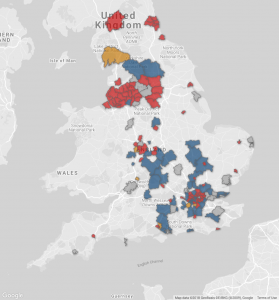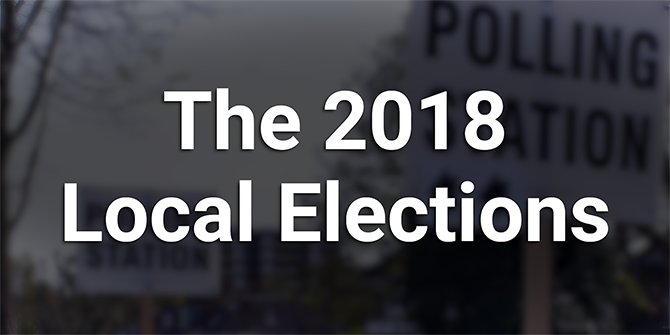On 3 May, voters across England have the chance to vote in elections to their local councils. The Democratic Dashboard is Democratic Audit’s voter resource, which brings together an array of information on the local elections taking place. Our aim is to simplify the complicated world of local elections in the UK, and present the essential information in an effort to boost participation. The UK has one of the lowest rate of electoral participation by young people in the OECD, especially at local elections, and we hope to play a part in using the digital environment to bridge the information gap, writes Joshua Townsley.
The Democratic Dashboard has been running since 2015 – and at a crucial time for British politics. Disillusionment and disengagement with politics is high; trust in politicians is low. Most people do not know who represents them. The situation is not helped by the often-complicated nature of elections in this country. There are numerous tiers of government in the UK for which voters are regularly asked to cast their ballots, including local councils, directly elected mayors, police and crime commissioners, national assemblies and parliaments. The first past the post system for local councils in England and Wales as well as Westminster also means that the nuances of local politics can vary significantly from place to place.
At the same time, people in general, especially younger people, are also becoming more and more geographically mobile, often moving house frequently, leaving home or going away to university for the first time. Many people do not even know what constituency or council area they live in. Knowing what exactly you’re voting for in this environment can be tricky.
The result is that for local elections, which determine the running of many of our public services, there is a yawning information gap. When are the elections taking place? Which party runs my local council? Is the control of my council likely to change hands at this election? According to Google Trends, the top election day searches are ‘Who should I vote for?’, ‘Who are my local candidates?’ and ‘Where do I vote?’. Participation at local elections is low, especially when they do not coincide with general elections, and turnout is usually between 30 and 40%. Having easy access to localised voter information is more relevant than ever.
The Democratic Dashboard’s mission is to provide the necessary information to help fill this gap. We are independent of any political party. We want to help promote engagement in the electoral process by making election resources more accessible and better tailored to your area. Using the Dashboard is easy. Simply put your postcode into the Dashboard’s home page, and you will instantly get information on the upcoming elections and political make-up of your area.
Where does all this information come from? The data is drawn from a variety of sources, including the House of Commons Library, the Electoral Commission and electoral information compiled by groups and individuals. More recently we have been able to add information on who the candidates are that are standing in your area, and a polling station locator so you can find out exactly where you need to go on election day to have your say. This information is only possible thanks to our friends’ crowdsourcing efforts over at Democracy Club. One of the key motivating factors behind the Dashboard is to bring this wealth of information together into one place.
We plan to continue improving the Dashboard, and to work with organisations to develop other projects such as the Local Democracy Dashboard that can help make local, civic information more accessible. But for now, we are focused on the forthcoming local elections. On 3 May, millions of voters in England have the opportunity to vote in elections to their local councils, and we hope that the Dashboard will come in handy again. The elections will determine which party, or parties, run the local council and the services for which it is responsible. There is also a great deal riding on the elections politically in the first major test of public opinion since 2017’s surprising general election.
Elections are taking place across England from Camden to Carlisle, Birmingham to Bromley, Swindon to Sheffield. You can use the Democratic Dashboard to check whether you have elections coming up in your area, who the candidates are, where you should vote and what the political balance of the council looks like.
Please excuse any initial gaps in the polling station or candidate information on the site. These should be filled the closer we get to 3 May. You can help our friends over at Democracy Club with their quest to locate all local election candidates ahead of next month.
This piece was originally published on the Democratic Audit blog.
 Joshua Townsley is a Research Assistant at Democratic Audit, responsible for the Democratic Dashboard project. He is also a PhD Candidate and Assistant Lecturer at the University of Kent, where he researches political behaviour and party campaigns. Josh can he found on Twitter at @JoshuaTownsley.
Joshua Townsley is a Research Assistant at Democratic Audit, responsible for the Democratic Dashboard project. He is also a PhD Candidate and Assistant Lecturer at the University of Kent, where he researches political behaviour and party campaigns. Josh can he found on Twitter at @JoshuaTownsley.
Note: this article gives the views of the author, and not the position of the LSE Department of Government, nor of the London School of Economics.







